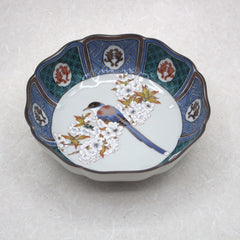Ko Kutani is Old Kutani, which refers to the Japanese porcelain that is the most beautifully crafted ceramic in the world. The intricate details of Japanese traditions painted in vibrant colors are nothing less than awe-inspiring. Still getting the world attention it deserves, Kutani ware goes back about 300 years.
Sources confirm that Kutani was first introduced in 1655. Lord Maeda Toshiharu ordered Goto Saijiro to take a trip to Arita Village located in the Hizen Province. This village in Saga Prefecture was the hub of Kutani porcelain and Goto Saijiro was assigned to learn the art. Kutani at the time was new and learning the glazing technique of porcelain was considered art.
The Ko Kutani Characteristics
Initially, the Saga Prefecture was popular for porcelain and beautiful ceramic. It was the birthplace of the most iconic and unique porcelain styles, such as Arita and Imari. These early styles of porcelain influenced the new Kutani ware. The older styles are now known as Ko Kutani or more commonly as Old Kutani. These references distinguish the two art pieces.
Kutani is the name of the village where the first porcelain kilns were built and operated in the Kaga Province. The first porcelain created bore a close resemblance to Imari and Arita. However, thanks to Goto Saijiro and his overglaze techniques, the difference is astounding. This technique ensured Kutani stood differentiated from its predecessors.
Additionally, the use of bold colors like green, blue, red, yellow, and purple made it stand out from others. Every new piece had a striking detail-rich in vivid colors. The result was enhanced imagery of scenes that spoke of Japanese history and culture. Every piece tells a story painted beautifully on porcelain.
Sadly, after the demise of Goto Saijiru in 1730, Kutani art was almost lost. Since he was, the only Kutani artist at the time without a family to pass it on it wasn’t exactly a lucrative business. Moreover, the infrequent distribution of Kutani pieces meant that it was not an established business.
This led to an early closure of Kutani kilns due to reasons unknown. While some speculate that the reason was lack of finances, others believe that it was the sourcing of raw materials that put an end to Kutani porcelain. On the other hand, this has made Kutani all the more valuable and rare to find. Today, Ko Kutani pieces are considered priceless and for all the right reasons too.
The Introduction of Saiko Kutani
After about 100 years, a young man named Aoki Mokubei decided to revive the lost art of Kutan in Kyoto. So in the 1800s, he was encouraged by Maeda Narinaga to bring back the Ko Kutani art. Only this time, it was called Saiko Kutani meaning ‘Revival of Kutani’.
The unique feature of Saiko Kutani was the addition of gold and red decoration on the overglazed enamel. This decorative technique is known as kinrande, which adds luxury and importance to every piece. If possible, the addition of gold and red colors to Kutani pieces only made it more valuable and unique.
Present Day Kutani
The final period in Kutani’s journey started in the 1860s in what is known as the Meiji era. This was the time when Kutani started to appear around Europe. Many kilns that had closed down after the initial fall started reopening and production once again went into full swing. Resultantly, many kilns started to export these pieces where they home with influential European families. The possession of Japanese porcelain was considered rich and magnificent.
Although Kutani is still being manufactured at a massive scale, the marvel of Ko Kutani is incomparable. Every piece tells a story that has been hand-painted with patience by true artists of Japan. Kutani ceramic art has a beautiful but broken and fragmented history. The beauty is so captivating that it has been rediscovered several times and will be appreciated for years to come.
Ko Kutani Style Products
The following products are Ko Kutani style and are available for Kutani enthusiasts. You can now own a piece of the historical Kutani art at the Japanese Kutani Store.
1.Old Kutani (Ko Kutani) Style Bowl Bird in Camellia
This bowl is the oldest representation of the Kutani ware period of 1600 and 1700. The main characteristics of this bowl are the vivid colors of purple, yellow and blue. Additionally, the bold flowers, birds and plants point towards its Ko Kutani origin. Buy it here.
2.Seiko Kiln Small Plate Old Kutani Japanese Folk Tales Style Kintaro
The famous Kutani-yaki kiln, Seiko is the creator of this small plate. Using Japanese paints to create this unique design with a depth of color enhances the charm of the work. This traditional pattern has been harmonized and modernized for present-day users and collectors. The image is based on the Kintaro story about a powerful boy who plays with monkeys and bears.
3.Old Kutani (Ko-kutani) Style Bowl Bird in Wild Cherry Tree
This is a bowl in the Old Kutani style, a representative style of the early Kutani ware period from 1600 to 1700. It is characterized by its bold designs of flowers, plants, and landscapes, using blue, yellow, and purple as the main colors.
This is a gem of a work of art, vividly colored with cherry blossoms in full bloom, one of Japan's representative plants.
4.Old Kutani (Ko-kutani) Style Bowl Bird in patulum
This is a bowl in the Old Kutani style, a representative style of the early Kutani ware period from 1600 to 1700. It is characterized by its bold designs of flowers, plants, and landscapes, using blue, yellow, and purple as the main colors.
See All Ko-kutani Style Porcelain Products











